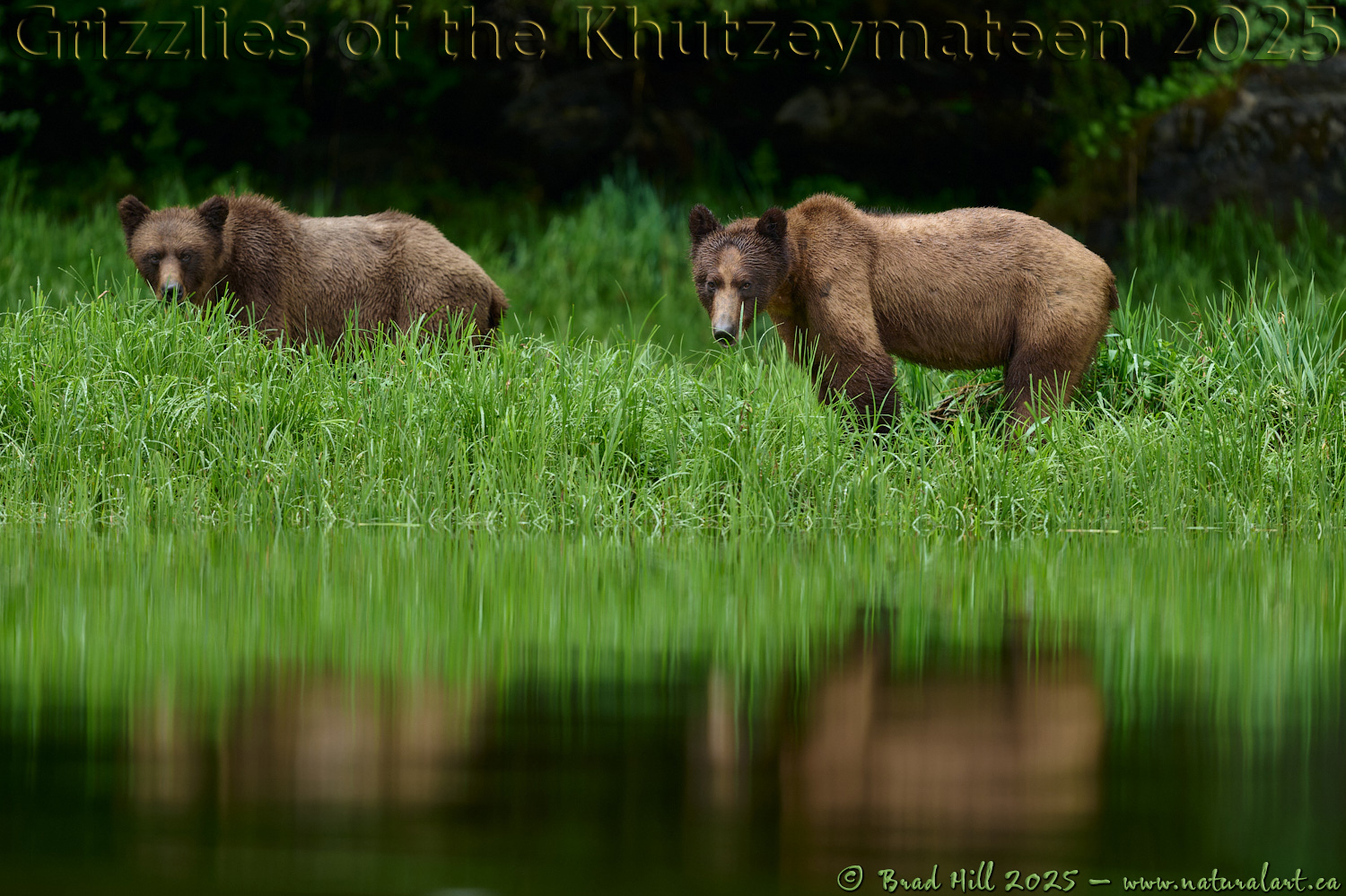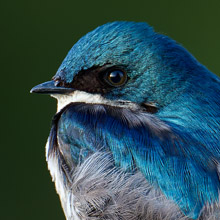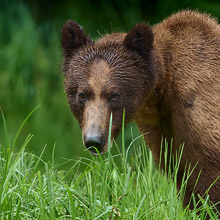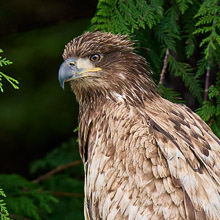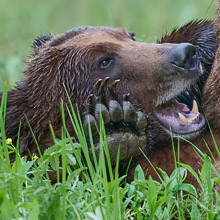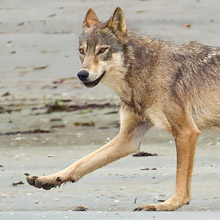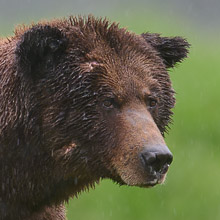Availability: Undetermined - Enquiries?
In the Field
Khutz Calm. Khutzeymateen Estuary, British Columbia, Canada. May 31, 2025.
When most folks think of serenity or tranquility it's unlikely many would think of it as occurring when photographing grizzlies in the wild! Yet when I was capturing this scene of a pair of courting/mating grizzlies that's exactly how I felt - completely calm and at peace. I'm not claiming that it's always like this when photographing bears in the Khutzeymateen - far from it (the weather in there CAN be awfully wet and generally inhospitable to upright hominid beach apes!). But when the weather and the bears are calm...it's wildlife enthusiast nirvana!
I found it tricky to capture and convey what I wanted to in this image (the sense of calmness/tranquility). Why? Well...because of the age old photographer's challenge of how to deal with multiple subjects. I REALLY wanted the foreground water in this scene - and the background behind the primary subject - to be rendered as softly as possible. This argued for the use of a very wide aperture on the Z 400mm f2.8S I was using at the time. BUT, this (of course) meant that the second bear (the one to the left of the shot and slightly further from me than the primary subject) would be rendered a little softly as well. So I debated stopping down (a LOT) to get both bears in focus (in which case I would have focused about half way between them)...but in the end I decided to go with my gut and shoot the image wide open to create the "soft look". I'm not sure this worked perfectly (and I'm sure some would say the second slightly out-of-focus bear "ruins" the image), but I do find myself drawn back to the image time and again, so it can't be all bad! 😉
Here's a larger version (4800 pixel) of these chilled-out ursids:
• Khutz Calm: Download 4800 pixel image (JPEG: 4.8 MB)
ADDITIONAL NOTES:
1. These images - in all resolutions - are protected by copyright. I'm fine with personal uses of them (including use as desktop backgrounds or screensavers on your own computer), but unauthorized commercial use of the image is prohibited by law. Thanks in advance for respecting my copyright!
2. Like all photographs on this website, these images were captured following the strict ethical guidelines described in The Wildlife FIRST! Principles of Photographer Conduct. As such, no baiting or any form of attractant was used and, as always, we attempted to minimize our impact on the ongoing behaviour of the subjects. I strongly encourage all wildlife photographers to always put the welfare of their subjects above the value of their photographs.
3. This image was captured during my Grizzlies of the Khutzeymateen Photo Op photo tour in late spring of 2025. Each year I offer photo tours into the Great Bear Rainforest and, every other year, photo tours into the Khutzeymateen Grizzly Sanctuary (to photograph grizzlies, of course!). Details about these trips can be found on the Photo Tours page of this website.
Behind the Camera
Khutz Calm. Khutzeymateen Estuary, British Columbia, Canada. May 31, 2025.
High Efficiency* Compressed RAW (NEF) format; ISO 450.
Nikon Z 9 paired with Nikkor Z 400mm f2.8S. Hand-held from a floating Zodiac inflatable boat. VR on in Sport mode. Single-point AF.
1/640s @ f3.2; -0.3 stop compensation from matrix-metered exposure setting.
At the Computer
Khutz Calm. Khutzeymateen Estuary, British Columbia, Canada. May 31, 2025.
Initial noise reduction and capture sharpening on the .nef (raw) file using the DeepPRIME XD2S algorithm of DXO PhotoLab 8.7 Elite (using the appropriate lens/camera optical module).
Subsequent adjustments to the adjusted linear DNG file (exported from PhotoLab) and conversion to 16-bit TIFF file (and JPEG files for web use) - including all global and selective adjustments - made using Capture One Pro (build 16.6.3). In the case of this image there were a number of very small tweaks to the HDR tools (highlights, shadows, whites, blacks) made to the entire image. Selective local adjustments performed using Capture One Pro's layers and masking tools. In this case numerous small adjustments and minor tweaks were made on 6 separate layers, with the tweaks being associated with "exposure balancing" and contrast adjustments (such as adjustments to brightness, clarity, highlights, shadows, etc.).
Photoshop modifications included insertion of the watermark and/or text.
Conservation
Khutz Calm. Khutzeymateen Estuary, British Columbia, Canada. May 31, 2025.
Species Status in Canada*: Special Concern (May 2002).
While Grizzly Bears (Ursus arctos) are not technically listed as "Endangered" in Canada, they have been extirpated from most of their historical range. Grizzly Bears are far more sensitive to intrusion/disturbance in their habitat than are Black Bears and are being increasingly forced into marginal habitat by human encroachment. The Great Bear Rainforest along the central and northern coast of British Columbia is one of the last strongholds of the Grizzly Bear in Canada, and even this population is coming under increasing pressure.
On December 18, 2017 the government of British Columbia banned grizzly hunting across the entire province. This major conservation victory came after decades of tireless work by many dedicated conservationists and ecologists and, most importantly, it reflects the opinion of the vast majority of British Columbians. And, it means that AT LEAST while the current government remains in power grizzlies are finally "safe" in British Columbia.
Now that we've at least temporarily won the battle to save grizzlies in BC, it's time to re-focus our efforts toward protecting ALL of BC's carnivores, including Gray Wolves, Black Bears, Cougars, Wolverines, and more! Simply put, there are no ecological, economic, or ethical arguments supporting the trophy hunting of carnivores.
*as determined by COSEWIC: The Committee on the Status of Endangered Wildlife in Canada













